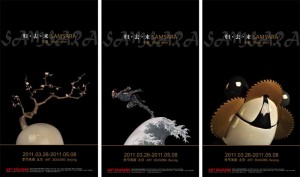 |
Art Seasons, Beijing
798 Art District No., 2 Jiu Xian Qiao Road,
706 North 3rd Street, Chaoyang District,
Beijing 100015, China map *
tel: +86 10 5978 9850
fax: +86 10 5978 9851
send email
website
|

Enlarge
|
| Samsara
|
|
| by Art Seasons, Beijing
Location: Art Seasons, Beijing
Artist(s): WANG Mian
Date: 26 Mar - 8 May 2011
Moving towards the light in the depth of the Soul
Gallery Commentary
Wang Mian says that he has always been on a pilgrimage, devoutly adhering to the most primitive ways. “Return, Come and Go” is a testimony to the artist’s ceaseless pursuit of dreams since 2005, and a trajectory of his own chase for the bright in the depth of his soul.
Born in the 1980s, Wang Mian grew up alongside China’s open-up and reform process. As China opened up, the introduction of western culture immensely enriched the childhood and cognitive understanding of his generation. Forcefully implanted into their brain, the heterogeneous and colorful Western civilization acted as a kind of “growth aide”, making it a force in parallel with the deeply imbedded and inherited traditional culture. Under such influence, Wang Mian was sensitive enough to feel the clashes of the two cultures and the encroachment they had upon each other. As he described, “On the one hand, I was canvasing a bright future world; on the other hand, I was falling in love with coke and instant food, while the aura around the Monkey King in the cloud was vanishing into thin air”.
With such thoughts in mind, Wang Mian started to look for a true journey in life. In 2008, he created the series of works entitled “Myths · Journey to the West”, in which the time-worn myth became the starting point of his dream and the classic was put into a modern context. As the four monks continue their westward journey, it evolves into a pilgrimage towards a cultural hegemony. Still, the journey is a perilous one but it is no longer a simple military conquest, in which, with Heaven-endowed power, demons and evil spirits are conquered. Having been cleansed by the real world, the monks are invariably marked with cultural colonization and the corrosion of material desire. Under the load of “burden” and “contradictions”, they have embarked on the road again and their westward journey is fraught with uncertainties and hesitations. “Journey to the West” is the essence of the Chinese tradition and many of us resort to it to bear the weight of our youthful heroic dreams, enshrining the book with the power of the most resilient perseverance and of justice. Walter Benjamin once said that tradition itself was living reality and that it changed all the time. Wang Mian is in compliance with such changes, and the new “Journey to the West” stages realism in a classic fashion: the variances of prevailing social problems make up the perils encountered by the monks; although strong and enduring, and garbed in brilliant armors, the heroic and courageous Monkey King could not avoid the sharp bite of the Howling Celestial Dog; the affectionate Pigsy sat paralyzed in the altered Guang Han Palace, solitarily brooding over his affection in the bygone days; with the intrepid Monkey tied down by the popcorn Five Elements Mount, the devout Tang Monk in the nook appeared so strange and insignificant. Would he salvage the Monkey? Whether we are hopeful or let down, expectant or disillusioned, we cannot shun the social problems triggered by cultural invasion and the bulging of material desires. Wang Mian has pulled reality into the realm of tradition, hoping that retrospection may unleash the pure light in the depth of our soul.
“Run Away” is a Pure Land the artist yearns for. The artist substitutes the word “ 逃” (run away) for the homophone “桃”. It is not just in the ancient time that men wish to avoid the contemporary world. Today, in our globalized world, rapid social development and abundance of material wealth are accompanied by negative side effects, as social problems frequently erupt, societal conflicts intensify and the vast majority of people live under heavy pressure and are often in the grip of predicaments, powerlessness and hesitation. The Celestial Peach Orchard is a heavenly sanitarium with fruits that ripen from 3000 years to 9000 years: the rarer the more powerful. The artist puts the Orchard into the cognitive process of understanding social evolution and reality. The Pure Land of the Orient gives him a strong sense of regress, and the replaced reality empowers him to ultimately attribute everything to the pure and the good. In the series “Blossom every 6000 years”, “Twins” stems from the impressions of different life experiences resulting from circumstance variations experienced by the twin brothers. We inhabit the same planet but all have different conditions and experiences in life; our varied sets of behaviors ultimately result in differences in life. Yet, being at the propitious millennium-old Peach Orchard, we can coexist in harmony. “Listening to the Flowers” depicts the action taken with eyes closed and heart open as the true way of feeling the real pulse of the world. Yet what in the world is flawless and unadulterated? We being irritated must believe in the existence of hope. Being the most primitive mode of transport, “Hot Air Balloon” and “Ferry” move with the wind and the tide, and are therefore in compliance with the natural order and the disorderly world. “Run Away” has a serene tint of the ancient time and a glint of real-life of today. To go back is to return. The artist, using a poetic license, discards the prosperity of today’s world and depicts serenity in a dreamlike fashion.
In “Descent from Heaven, lesser divinities like “鱻”(Xian)、“鑫”(Xin)、“炎”(Yan)、“羴”(Shan)、“飝”(Fei) descend from Heaven to experience civilian life in its myriad forms. In so doing, their appearance and frame of mind also change. In ancient time, retaining a sense of auspice, triple reiterative words were usually associated with the five elements and six domesticated animals. In Wang Mian’s work, however, they take on an added meaning: the blind fever for adding things up and the excessive explosion of material desire. The descended deities start to transform themselves, first with compulsory intervention: the exposed mechanical joints, foreign branded gears, golden and sharp wheels, artificial wings replacing natural wings, dazzling steel-like armors etc., all of which depicts aggression turned occupation that is not becoming for their bodies. Secondly, the mutation of their bodies: the sharp claws and teeth, degenerative wings, mutated faces with black tears lurking behind the skulls. These do not fill one with fear; instead, they give rise to compassion and sympathy. Also, there are masks and headwear: atop “鱻”’s head is a whale showing its rows of golden teeth, a mutated scene of avariciousness; the cool and cruel steel mask that “炎” wears tears prosperity into pieces and insulates the heart; the clownish mask “羴” wears is indicative of his inner contradictions; the giant goggles “飝” has are rather baffling. The goggles look like eagle’s eyes. Are they or those below the goggles the real eyes? In Chinese mythology, deities come from Heaven to safeguard and guide people towards peace and bliss, bringing light to the civilian world. But where there are deities, there are demons. When deities bump into and become demons, mayhem will ensue. Heaven and earth in fact are both in our heart. Also within our heart is a celestial being -- the light in the depth of our soul.
If “Run Away” sends a signal of hope and expectation (“return”), then “Descent from Heaven” is a portrait of reality (“Come”), and “Myth · Journey to the West” the journey that we are contemplating (“Go”). Wang Mian calls it Samsara. Using the cycle, he links the past, the present and the future together, and depicts the varied phenomena and confusion in the course of globalization, through such artistic means as revelation, displacement, reversion, metaphor and questioning, provoking thoughts and aspiring people to unearth the truth. Wang Mian is an artist with steadfast artistic ideals, who often brings up the word “light”. Light is both a fact and a belief. The artist is like a faithful pilgrim who constantly watches and explores, guarding at all times the light in the depth of soul. |
|
|
|
|
